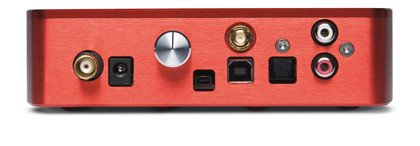TechRadar Verdict
Pros
- +
Characterful in a good way
- +
Engaging and lively
- +
Generally good detail
Cons
- -
Not always the most revealing
- -
Lacks a little focus
Why you can trust TechRadar
Following in the footsteps of the Chordette Gem, which brought Chord's DAC expertise to a lower-budget audience, as well as the company's unique Bluetooth technology, the Peach is basically a Gem with electrical and optical S/PDIF inputs added.
The circuit board inside actually bears the legend 'Gem Mk 2' and comes in the same small case – a shrunk version of the legendary DAC64 finished, in this case, in fetching red.
The Bluetooth input is interesting, as it uses the 'advanced audio distribution profile' (A2DP) feature of the Bluetooth standard to stream higher-quality audio than is normally allowed by this dedicated short-range wireless system. It's not actually lossless, but when used with the APT-X codec, the quality is pretty decent.
The point is to allow not only computers, but also mobile phones, to stream data conveniently to the main hi-fi , without wiring things up.
Inside the Peach, an implausibly thin screened cable connects a socket for the Bluetooth antenna to a tiny sub-assembly with Chord's own receiver circuitry. This then feeds the main circuit board, also the home of the usual digital input chips and the DAC chip.
The latter is a recent part which not only converts to analogue but includes line driver circuits which remove the need for separate op-amps to drive the output sockets.
We love the milled-from-solid aluminium case and the overall look is very appealing. It's obvious which socket on the rear is which (and you can't confuse analogue with digital as the latter uses a BNC connector), but it's far from obvious which input is selected as the rotary switch is unlabelled.
Sign up for breaking news, reviews, opinion, top tech deals, and more.

Note that the USB input is limited to 48kHz sampling rate.
Sound quality
Connected via the usual S/PDIF, this DAC was well-liked, but didn't entirely escape criticism. Sifting through their notes, we noticed that a very slight lack of clarity, precision and focus was the main issue.
In the Led Zeppelin track we used for testing, for instance, one listener found it energetic, lively and fully in tune with the musical aims, while another missed some energy and commitment.
Our Otis Redding number drew comments about vocals sounding clear and lifelike but backed by an unusually recessed and constrained band, while the classical vocal track seemed to be just a little rough compared to the presentation heard from some of this group.
It's worth noting that in our sighted listening, we found this a relatively 'characterful' DAC which, however, gave a very informative presentation once one has acclimatised.
It's true it's not the most ruthlessly revealing, and we did occasionally wish for a little more insight (particularly in complex, multi-layered recordings), but it is certainly good on the rhythm and pace front and easy to like with rock music.
We tried both 'default' and APT-X Bluetooth and liked the latter a lot, though the former is noticeably compromised in most material.
Follow TechRadar Reviews on Twitter: http://twitter.com/techradarreview
